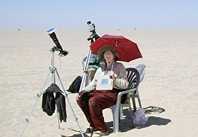Life's one eclipse after another
On the wall outside Cherrill Spencer's office, a scientific poster describes a prototype for a new type of accelerator magnet; a card thanks her for donating her long hair to make a wig for an ailing girl; and a scribbled note points to a spot on a map southeast of Novosibirsk, Russia. It reads, “This is where Cherrill will be on 1st August, 2008 at ~17h Siberian time.”
Above it is a photo she shot, from that out-of-the-way spot, of a total solar eclipse.
It's one of dozens Spencer has taken since 1983, when her first eclipse, on the island of Java in Indonesia, gave her a new focus for planning vacations. Eclipse-chasing has taken her to Hawaii, Zambia, Australia, and Libya. She saw the sun wink out from a ship on the Caribbean and waited in an English drizzle for the clouds to part—which they finally did, for 10 seconds.
  |
| Photos courtesy of Cherrill Spencer |
“I like to travel,” she says, “and it was an excuse to go to all these places. I choose my total eclipses based on where they are, and whether I'd like to visit that place, and whether I've been there before.”
As the magnet engineer for SLAC National Accelerator Laboratory, Spencer designs magnets and follows them through construction and measurement. She also puts in many hours as a volunteer for programs that encourage girls and women to take up scientific careers.
It's no surprise, then, to hear that she started taking her daughter to eclipses at the age of three. Sierra is now 14, Spencer says, and “probably holds some sort of record for how young she is and how many total eclipses she's seen.”
The experience is incredible, she says, and not just for the eclipse itself.
In Zambia, her group camped along the Zambezi River and drove three hours at about 10 mph—“along the worst road in the world,” she adds—to a national park. When the sun dimmed, casting an eerie twilight over the land, “The animals thought it was time to go to bed. The baboons started chattering. They sleep in trees, and they started arguing about who gets to sleep where.”
Spencer is already planning her next eclipse in July 2009, which she'll watch with 1600 other people from a cruise ship near Iwo Jima.
With six minutes and 39 seconds of totality, she says, “This is going to be the longest one in our remaining lifetimes.”
Glennda Chui






